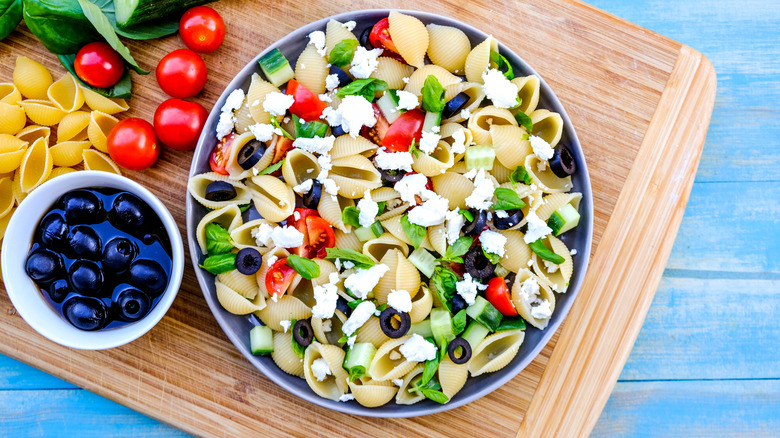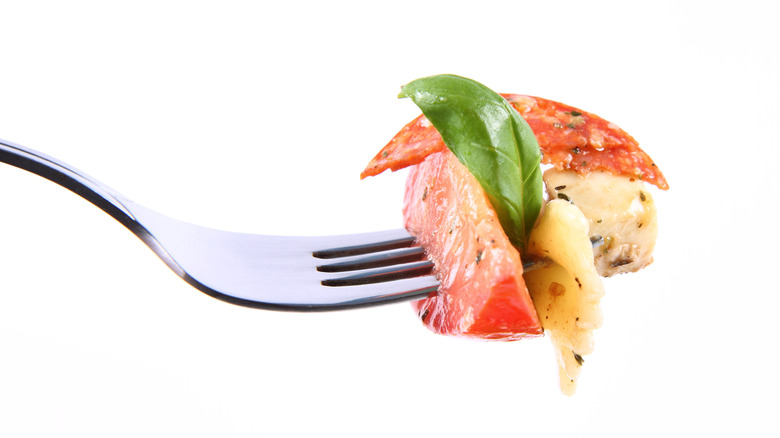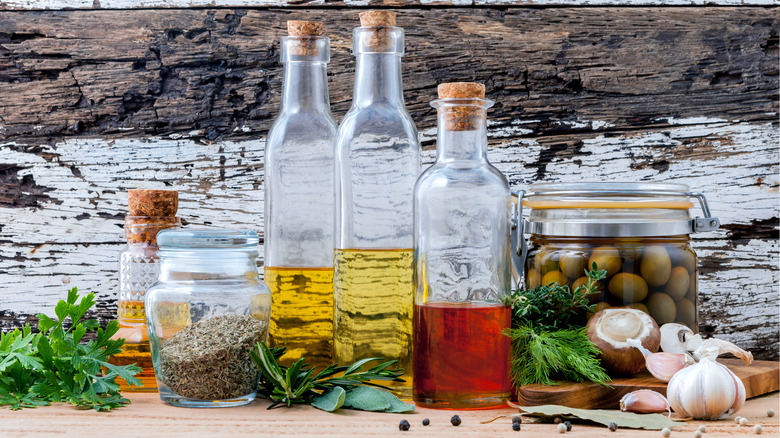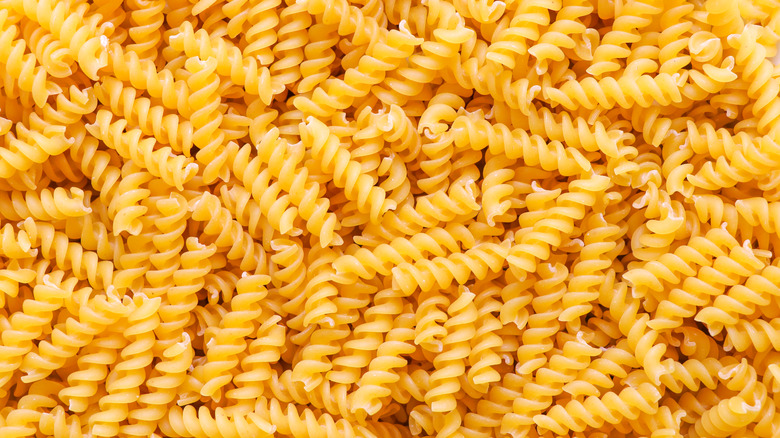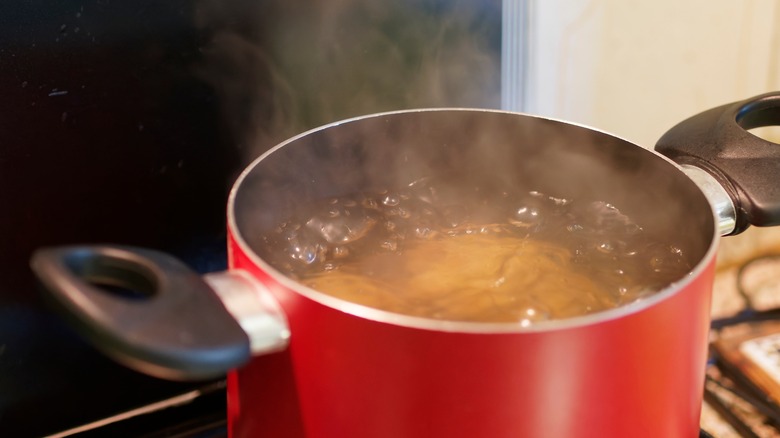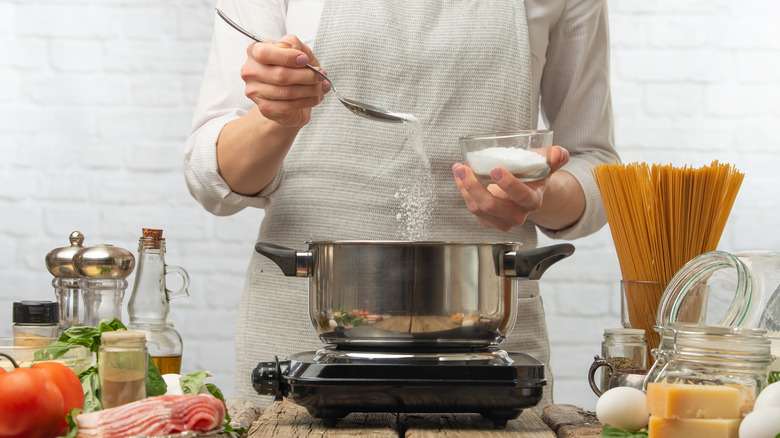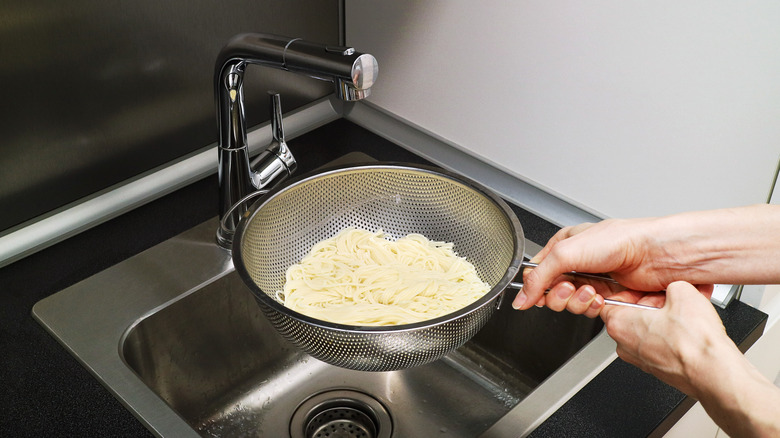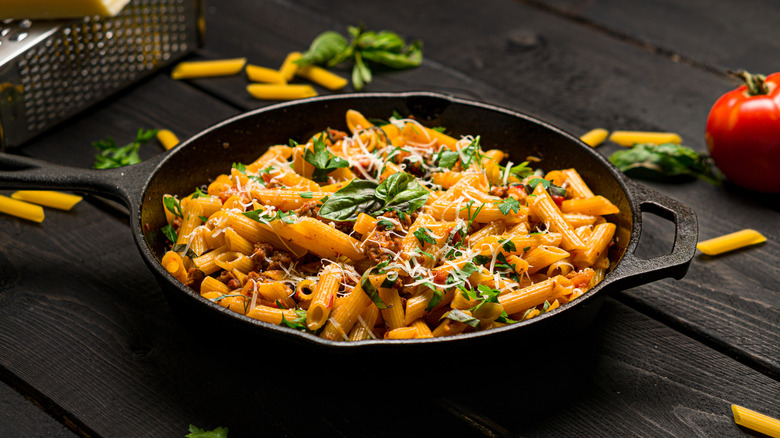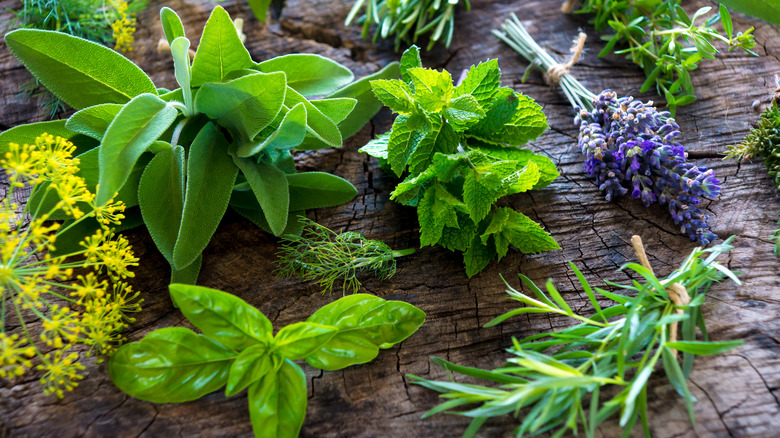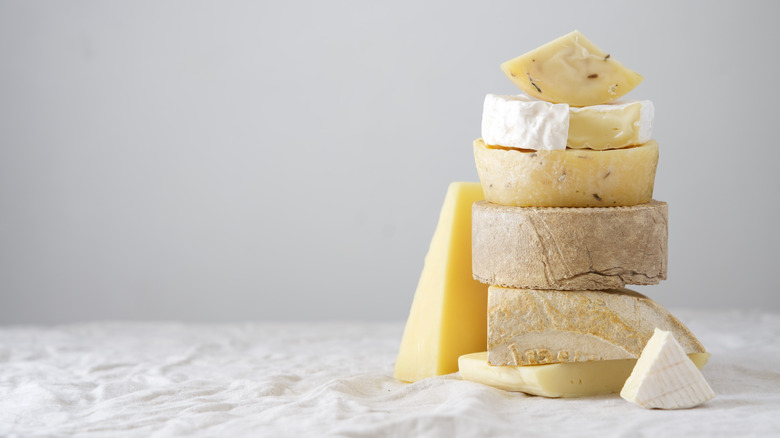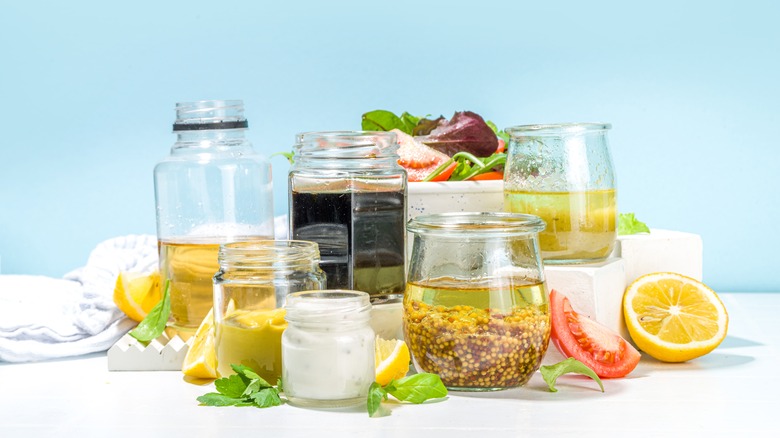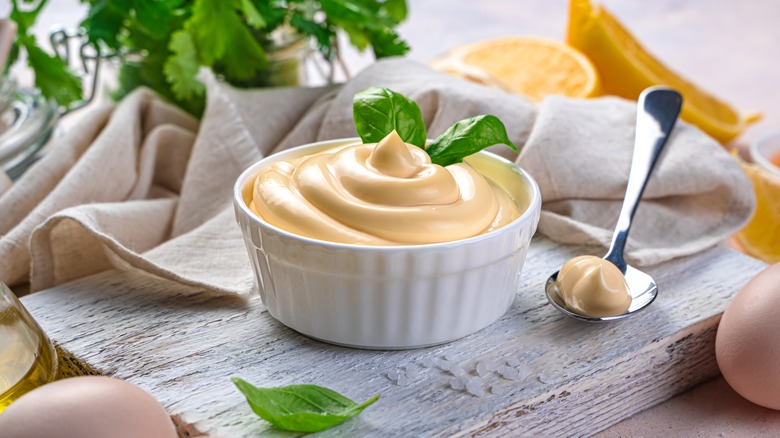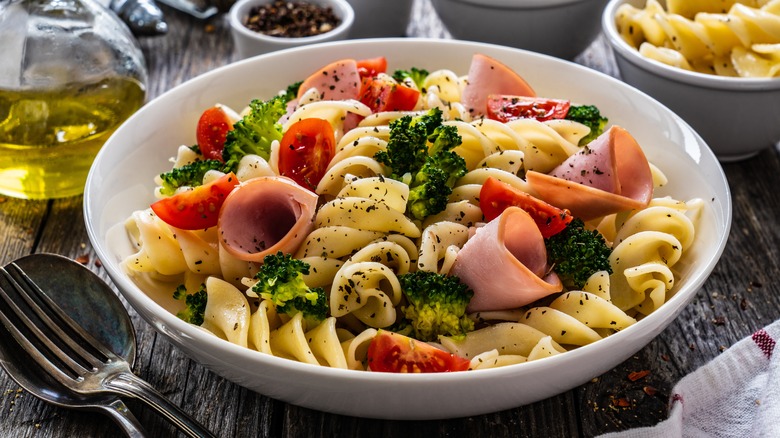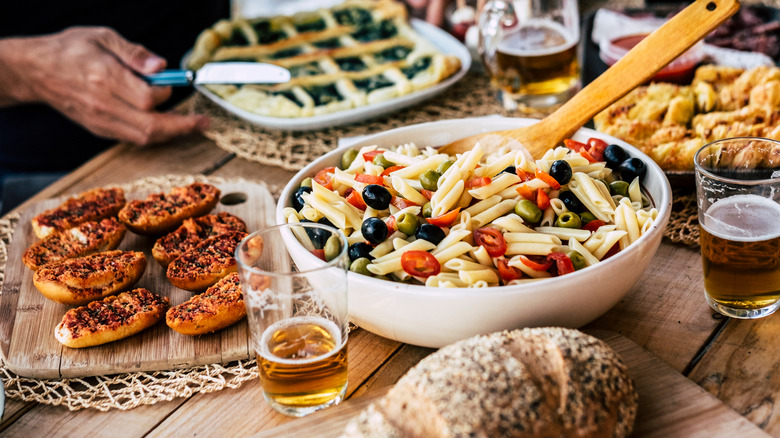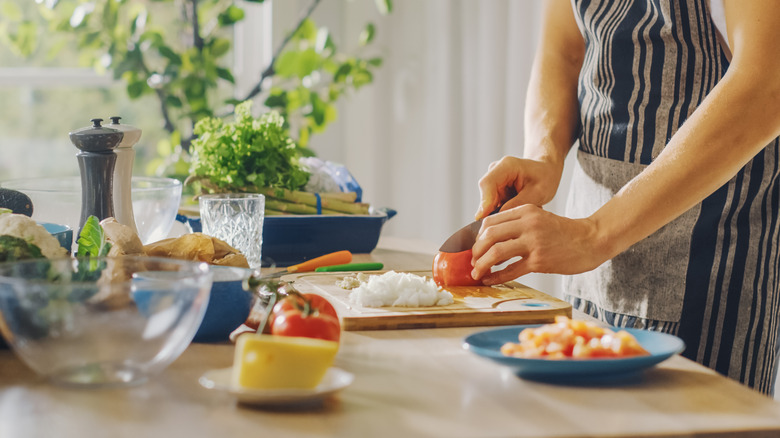14 Tips You Need To Make The Ultimate Pasta Salad
Pasta salad is a long-standing favorite gracing picnics and potlucks across the country. Despite pasta's Italian origins, pasta salad is decidedly American, because Italians don't eat cold pasta or serve it as a side dish. It's speculated that in the early 1900s, Americans combined the pasta brought over by Italian immigrants with elements from the potato salads dressed in mayo that came to the U.S. courtesy of German immigrants (via Dagostino). Today, a summer barbecue wouldn't be complete without it.
The only non-negotiable ingredient in pasta salad is its namesake ingredient, so the beauty is in the mix-ins. You can go creamy or use a vinegar base. Keep it mild or spice things up. You can even make a sweet frog eye pasta salad that is practically a dessert.
But what if, in anticipation of a forkful of delightful carb-y goodness, you are met with mushy noodles, bland and heavy dressing, and slimy cubes of cheese instead? By following these tips to create the ultimate pasta salad, it will be easy to avoid these mistakes and wow everyone at the next cookout (and ensure you're invited back). Read on to transform your pasta salad from blah to ah!
Contrast and proportion are key
Because so many ingredients come together in pasta salad, planning for a harmonious whole will reward you with a satisfying bite every time. Keep interest high with a combination of textures that includes firm, soft, cooked, and raw ingredients. Blanching or steaming tough veggies like broccoli until tender will reduce the contrast with the softer pasta and make them easier to eat, and marinated veggies provide softness as well as a flavor boost. Adding something crunchy like chopped raw veggies or a handful of nuts or seeds will also boost the texture count.
The proportion of pasta to mix-ins will affect the overall dish's harmony as well. Chop ingredients to a size that complements your chosen pasta shape. Spare your guests the misery of trying to scoop up a plateful of tiny veggie pieces after the pasta is gone. The goal is to pick up a little of everything with your fork, so chop veggies about the same size as the noodles or a little smaller.
Amp up the flavor
Pasta salad has come a long way from those uninspiring versions made with bland mayo dressings and bits of raw celery. Recipes abound with creative ingredients and techniques that supercharge flavor. Think in terms of categories like salty, sweet, spicy, or acidic when considering which ingredients to include. Salty mix-ins such as cheese, capers, or cured meats can elevate the flavors of the individual ingredients and help them meld together. Choosing roasted, salted veggies over blanched or raw ones will increase the veggies' impact on the dish.
Bringing a touch of sweetness to pasta salad can create a delightful contrast. Add honey or maple syrup to a classic vinaigrette for a fresh twist on this classic dressing. Also considered cubed fruit like mangoes or strawberries. If you're looking for a spicy kick, tangy pepperoncini peppers are a great candidate. Just adjust the quantity to dial the heat up or down according to taste. One ingredient that will change your pasta salad forever is pickle juice. Food stylist Kelly Paige remarked that it "adds a brightness to dishes with a pop of acidity, sourness, and tang. Think of it as a one-stop shop for flavor" (via Today).
Use the right pasta shape
According to Paesana, there are 350 different Italian pasta shapes encompassing a vast variety of sizes, circumferences, and nooks and crannies that make each ideal for pairing with a certain kind of sauce. Even though pasta salad isn't served with sauce, the right pasta shape will maintain the integrity of the dish and make it more appetizing.
At the bare minimum, use dry pasta with a short length. Fresh pasta is too fragile to be immersed in dressing for hours or days, and long pasta like spaghetti is intended to be wrapped around a fork. Tortellini and other filled pasta should also be avoided, as the meat or cheese fillings will acquire an unappealing texture when cold. Short pasta shapes like gemelli, radiatori, cavatappi, orecchiette, and casarecce work much better. The channels and depressions on these shapes are sauce magnets that allow dressing to adhere to the pasta instead of slipping off.
Perhaps the best shape for pasta salad is fusilli. Pasta salad dressing not only collects inside the spiral shape for a more flavorful bite, but the coil adds flexibility so it springs back upon contact with the other ingredients instead of splitting into small pieces.
Cook pasta just past al dente
For those of you on team al dente who flinch at the thought of overcooking pasta, know that the game changes when the pasta is served cold. The reason for this is a process called retrogradation, which causes the pasta to harden as the water that enters the starch molecules during cooking is released as the pasta cools. The solution is to overcook pasta salad noodles for two or three minutes and then let them cool. As they cool they will return to al dente.
A note about overcooking: be careful not to exceed the two to three extra minutes beyond al dente, because even retrogradation has its limits. Pasta cooked longer than that will make your pasta salad mushy and unappetizing. The al dente cooking times printed on pasta boxes can vary, so to be sure to cook it to the desired firmness for the ultimate pasta salad, start testing the pasta a couple of minutes before the time listed on the box. Test it every 30 seconds or so until it reaches al dente and then set a timer for two to three more minutes.
Don't skip the salt when boiling pasta
Is salting the pasta water necessary? Will it really make the pasta cook faster? Many people are confused about the role of salt in the cooking water. Though adding salt to pasta water may only slightly decrease the cooking time, it will make a big difference in the flavor of the pasta. Salt is absorbed all the way into the interior of the noodles while the water boils at a high temperature which, unlike salting the outside of the noodle after it's cooked, results in more evenly seasoned pasta. This added flavor is essential for cold pasta salads because the extra seasoning compensates for the loss of flavor that occurs when pasta cools.
Use at least 1 tablespoon of salt for every 5 quarts of water. Make sure you fill the pot with enough water to allow the pasta to move around freely while boiling, and stir the pasta a couple of times during the first minute or two. This will ensure that the pasta cooks evenly and does not stick to itself or to the bottom of the pot. Lastly, oil has no business in pasta water; it won't prevent the pasta from sticking (stirring will take care of that).
Avoid rinsing cooked pasta
Many people swear by rinsing pasta after draining it, while others won't hear of it. The problem with rinsing is that it removes the starch which helps the dressing stick to the pasta. That's especially a problem for cold pasta salad, which needs the dressing to evenly coat each noodle instead of dripping to the bottom of the serving dish.
Team rinse advocates running the pasta under cold water to immediately stop any further cooking that can occur after it's taken off the heat, but there's another way to cool the pasta without removing that starchy goodness. Instead of rinsing, the best way to cool pasta for pasta salad is to drain the pasta and lightly coat it in olive oil to discourage it from sticking, and then arrange it in a single layer on a baking sheet until it turns from hot to warm. Most pasta salads benefit from being dressed while warm, so for best results, this is the time to toss it with dressing.
Make a warm pasta salad
While pasta salad is a versatile dish with ingredients that can be mixed and matched in countless ways, there is one thing most recipes have in common: they're served cold. Cold pasta salad is welcome at summertime barbecues and picnics where it's traditionally served, but why miss out on such a delicious dish when the mercury drops? During cool weather months, consider adding warm pasta salad to your side dish repertoire.
Prioritize comforting ingredients such as chicken, beans, and cheese for your warm pasta salad. We also recommend taking advantage of seasonal produce — a blend of roasted fall vegetables is a great addition. Unlike their cold counterparts, warm pasta salads are best served immediately after the ingredients are mixed with piping hot drained pasta. If you want to switch up your sides roster this holiday season, you can go wrong with a warm pasta salad.
Add fresh herbs
There's a simple way to enliven pasta salad with a burst of fresh flavor, and that's with the humble herb. A bit of chopped fresh herb in every bite will delight the taste buds, and the aroma will have mouths watering before anyone digs in.
Delicate herbs like basil, parsley, cilantro, tarragon, and mint will work wonders in pasta salad. Use hearty herbs like sage or rosemary with caution because of their strong flavor and tougher leaves and stems. Because tender herbs lack a rigid structure, they dry out more quickly, and all herbs are prone to oxidation, which causes browning and wilting over time. Since pasta salad is often made ahead, you can preserve the firmness and bright colors of the herbs by chopping and adding them right before serving. A squeeze of lemon juice at the same time will complement many recipes and will not only brighten the taste of the dish but will also help prevent the chopped herbs from browning.
Unless you have pots of fresh herbs and can snip them at the last minute, keep the cut herbs you purchased fresh and colorful by storing them properly until you're ready to use them. Standing delicate herbs in a container with a small amount of water covering the cut stems and covering the leaves with a lid or plastic bag will seal in freshness and preserve them for one to three weeks in the fridge.
Choose your cheese wisely
Attention cheese lovers: Include your favorite cheese for flavor and turn pasta salad into a complete meal at the same time. In this case, not all cheeses are created equal. Differences such as fat content and texture make certain types of cheese more suited to a cold dish that may rest for hours or even a day or two before serving.
With so many options, it may be tempting to overdo it, but avoid the everything-and-the-kitchen-sink mentality and include just one kind of cheese that will play nicely with the other ingredients. Choose soft cheeses like mozzarella, ricotta, or goat cheese for a creamy texture, or opt for hard grated cheeses like Parmesan or ricotta salata, which add a salty and umami-rich bite without any bulk. Grate, rather than shred, hard cheeses to prevent clumping. Crumbly cheeses like feta or blue cheese work well both for their tang and because they can be spread out evenly over the dish. Avoid overly creamy cheeses like brie because they don't hold together. If you're making pasta salad ahead of time. Hold the fragile cheeses like feta until right before serving so they don't get too wet while they sit in the dressing.
Make your own dressing
It's easy to reach for a bottle of salad dressing, but making your own doesn't have to be complicated and you'll be rewarded with a wider range of options and fresher flavors. There are many salad dressing recipe ideas that work well in pasta salad. Go for a mayonnaise-based dressing if you prefer a creamy macaroni salad recipe, or whisk up a basic vinaigrette for a lighter touch. Explore the versatility of vinaigrette by combining Dijon mustard for a stronger finish, or add lemon juice and fresh herbs for brightness. A sweet version with honey or maple syrup provides a subtle contrast with the savory salad, and pepperoncini is a great addition for some heat.
When using vinegar for pasta salad, use a light touch. Too much vinegar creates an overly acidic dressing with a strong flavor that can cover the taste of the other ingredients. In particular, avoid balsamic vinegar because, besides the acidity, the dark color tones down the visual appeal of the bright, colorful ingredients.
Don't be afraid to think outside the box. Dress pasta salad with pesto or use avocado as a base. Blending brined ingredients like capers, pepperoncini, roasted red peppers, or sun-dried tomatoes into the dressing thickens it, helps it adhere to all of the noodles, and adds a rich, salty flavor. Whatever you do, never add butter to pasta salad. While it may seem like a great way to add a creamy consistency, once the pasta salad cools the butter will solidify.
Play up the mayonnaise
Classic macaroni salad with creamy mayonnaise dressing has the potential to be a tasty and fun staple. Unfortunately, it often gets a bad rap when it's not done well. The two most common mayonnaise mistakes are making the dressing too heavy or too bland. While a heavy hand with the mayonnaise can be acceptable with pasta salad too much of the condiment could overwhelm the flavor of the individual ingredients and makes the dish too bulky.
You don't have to ditch this popular spread if you're craving that creamy goodness that only mayonnaise can bring. Manage the mayo by cutting the heft with sour cream to make it lighter or with yogurt for a lower-fat version. Olive oil is often used as a mayonnaise substitute for pasta salad, so making a dressing with half mayonnaise and half olive oil is another way to lighten up the dish while keeping it creamy.
Season mayo-based dressings to keep blandness at bay. Include aromatics such as fresh herbs, scallions, minced onions, and even garlic. When using sour cream, the sharpness of the cream lifts the flavors of the dressing just as fresh lemon juice would to other dishes, For the best of both worlds, try a green goddess dressing recipe that combines fresh herbs for flavor and scratch-made mayo paired with avocado for lightened-up creaminess.
Dress while warm
The ultimate pasta salad features dressing that perfectly coats the noodles and mix-ins for a moist and fully-flavored bite. Dressing is meant to cling to the ingredients instead of forming a disappointing pool at the bottom of the bowl. The key to avoiding pooling is to dress the pasta while it's still warm. This is recommended because starchy carbohydrates like pasta will do a better job soaking up the dressing, so dressing the dish before it cools will give the flavor a boost.
A caveat: be careful with mayo. While oil-based dressings can be applied even to hot pasta, make sure to let the pasta cool to a warm temperature before mixing in a mayo-based one. Mayonnaise is susceptible to separating, but it can be warmed as long as it's not overheated. (The last thing you want is a bite of cooked mayo.)
You'll also want to avoid overdoing it on the dressing. There's a fine line between a rich, moist pasta salad and a wet, mushy one, so it's best to exercise some restraint. You can always add more before serving if it's too dry.
Dress twice
For perfectly moist results, dress twice. After cooking, dress pasta salad with two-thirds of the dressing at the most, because as the pasta cools it will absorb more of it. It's especially important to go easy on the initial dressing application when making the dish ahead of time so the pasta doesn't soak up too much moisture as it sits.
As for the second time, add the rest of the dressing right before serving. Pasta will dry out and may stick together as it sits in the fridge, so after bringing the pasta salad up to room temperature, pouring on a little more dressing before serving will restore the desired level of moisture.
Dressing twice applies to the seasoning as well as dressing, so remember to taste test for salt before serving. You'll need to add a little more than you would use for a hot pasta dish. Chilled foods tends to have a muted taste, so extra seasoning will give the dish the right amount of flavor.
Make pasta salad ahead of time
Since pasta salad develops more flavor after it rests for a time in the dressing, making it ahead is not only a time saver but also results in a tastier dish. The ingredients can be prepped anywhere from a few hours to three to four days before serving, per Does It Go Bad, so it's easy to make it when it's most convenient.
Make sure to bring your pasta salad back up to room temperature after it sits in the fridge. Serving it ice cold will change the textures and flavors, and not in a good way. When chilled, pasta becomes firmer, fats harden, and flavors take a dive. Waiting until the pasta has warmed up to room temperature will allow the intended flavors and textures to return. Just be careful not to leave it out for longer than two hours to reduce the risk of illness from bacterial growth.
The key to making pasta salad ahead of time while keeping it looking and tasting fresh is to hold back on some of the dressing and fragile ingredients until right before you plan to serve it. Reserve the fresh herbs and soft cheeses, which can wilt or get overly soft if they sit too long in a moist dressing, and toss them in with a little more dressing before serving. The result will be both maximum flavor and freshness.
